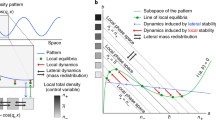Abstract
One of the elementary processes in morphogenesis is the formation of a spatial pattern of tissue structures, starting from almost homogeneous tissue. It will be shown that relatively simple molecular mechanisms based on auto- and cross catalysis can account for a primary pattern of morphogens to determine pattern formation of the tissue. The theory is based on short range activation, long range inhibition, and a distinction between activator and inhibitor concentrations on one hand, and the densities of their sources on the other. While source density is expected to change slowly, e.g. as an effect of cell differentiation, the concentration of activators and inhibitors can change rapidly to establish the primary pattern; this results from auto- and cross catalytic effects on the sources, spreading by diffusion or other mechanisms, and degradation.
Employing an approximative equation, a criterium is derived for models, which lead to a striking pattern, starting from an even distribution of morphogens, and assuming a shallow source gradient. The polarity of the pattern depends on the direction of the source gradient, but can be rather independent of other features of source distribution. Models are proposed which explain size regulation (constant proportion of the parts of the pattern irrespective of total size). Depending on the choice of constants, aperiodic patterns, implying a one-to-one correlation between morphogen concentration and position in the tissue, or nearly periodic patterns can be obtained. The theory can be applied not only to multicellular tissues, but also to intracellular differentiation, e.g. of polar cells.
The theory permits various molecular interpretations. One of the simplest models involves bimolecular activation and monomolecular inhibition. Source gradients may be substituted by, or added to, sink gradients, e.g. of degrading enzymes. Inhibitors can be substituted by substances required for, and depleted by activation.
Sources may be either synthesizing systems or particulate structures releasing activators and inhibitors.
Calculations by computer are presented to exemplify the main features of the theory proposed. The theory is applied to quantitative data on hydra — a suitable one-dimensional model for pattern formation — and is shown to account for activation and inhibition of secondary head formation.
Similar content being viewed by others
References
Barth,L.G.: The process of regeneration in hydroids. Biol. Rev. 15, 405–420(1940).
Bode,H., Berking,S., David,C.N., Gierer,A., Schaller,H., Trenkner,E.: Quantitative analysis of cell types during growth and morphogenesis in hydra. Wilhelm Roux' Arch. (in press).
Burnett,A. L.: A model of growth and cell differentiation in hydra. Amer. Naturalist. 100, 165–189 (1966).
Child,C.M.: Patterns and problems of development, Chicago: Univ. of Chicago Press, 1941.
Crick,F.: Diffusion in embryogenesis. Nature 225, 420–422 (1970).
Crick,F.: The scale of pattern formation. Symp. Soc. exp. Biol. 25, 429–438 (1971).
Delbrück,M.: Discussion to paper by Sonnenborn and Beale. In: Unités biologiques douées de continuité genetique. C.N.R.S., Paris, 1949.
Goodwin,B.C, Cohen,H.M.: A phase-shift model for the spatial and temporal organization of developing systems. J. theor. Biol. 25, 49–107 (1969).
Hartline,H.K., Wagner,H.G., Ratliff,F.: Inhibition in the eye of limulus. J. gen. Physiol. 39, 651–673 (1956).
Lawrence,P.A.: Gradients in the segment: the orientation of hairs in the milkweed bug oncopeltus fasciatus. J. exp. Biol. 44, 607–620 (1966).
MacWilliams,H.K., Kafatos,F.C., Bossert, W.H.: The feedback inhibition of basal disk regeneration in hydra has a continuously variable intensity. Develop. Biol. 23, 380–398 (1970).
Schaller,C.H.: Isolation and characterisation of low molecular weight substances activating head and bud formation in hydra. J. Embryol. exp. Morph. (in press).
Schaller,H., Gierer,A.: Distribution of the head activating substance in hydra and its location in membraneous particles in nerve cells. J. Embryol. exp. Morph. (in press).
Spiegelman,S.: Physiological competition as a regulatory mechanism in morphogenesis. Quant. Rev. Biol. 20, 121–146 (1945).
Turing,A.: The chemical basis of morphogenesis. Phil. Trans. Roy. Soc. B 237, 32(1952).
Waddington, C.H.: Principles of embryology, on p. 417. New York: MacMillan Comp. 1962. The term “primary pattern” is introduced on p. 417.
Webster,G., Wolpert,L.: Studies on pattern regulation in hydra. J. Embryol. exp. Morph. 16, 91–104 (1966).
Wilby,O.K., Webster,G.: Studies on the transmission of hypostome inhibition in hydra. J. Embryol. exp. Morph. 24, 583–593 (1970).
Wilby,O.K., Webster,G.: Experimental studies on axial polarity in hydra. J. Embryol. exp. Morph. 24, 595–613 (1970).
Wolpert,L.: Positional information and the spatial pattern of cellular differentiation. J. theor. Biol. 25, 1–47 (1969).
Wolpert,L., Hicklin,J., Hornbruch,A.: Positional information and pattern regulation in regeneration of hydra. Symp. Soc. exp. Biol. 25, 391–415 (1971).
Author information
Authors and Affiliations
Rights and permissions
About this article
Cite this article
Gierer, A., Meinhardt, H. A theory of biological pattern formation. Kybernetik 12, 30–39 (1972). https://doi.org/10.1007/BF00289234
Received:
Issue Date:
DOI: https://doi.org/10.1007/BF00289234




